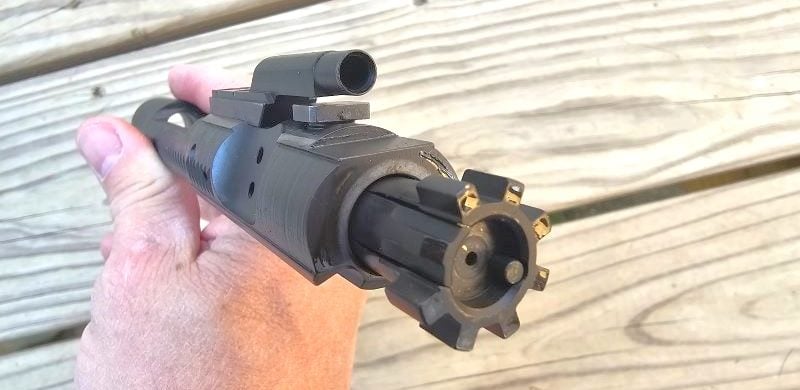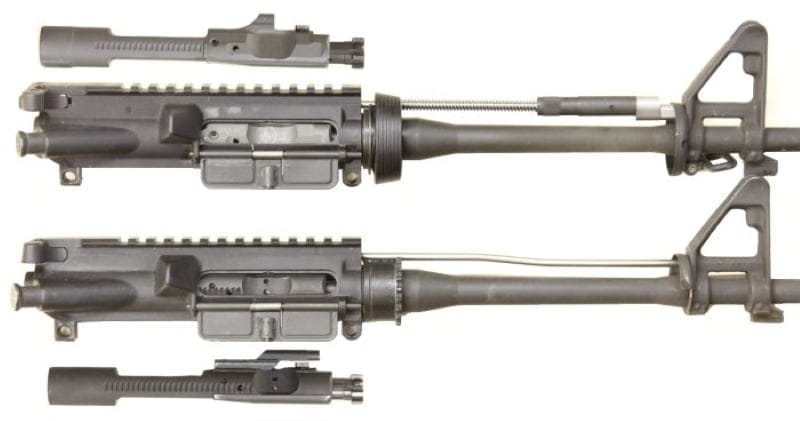The oft-asked question regarding Direct Impingement vs Piston Driven systems is: Which one is better?
As with other gun details, there are two camps, and each can be somewhat entrenched in its opposing stance. There are those who will defend one side or the other to the bitter end.
Direct Impingement vs. Piston Platforms: Direct Impingement
There are a number of semi-auto platforms out there with a large number of them using either the Direct Impingement system or the Piston-Driven system. The one that really seems to garner the most controversy is the AR-15 system. The Direct Impingement system was the original design.
The AR-15’s gas system uses a gas port in its barrel that siphons away a portion of the gas expended when a round is fired. The gas travels through the gas block (usually underneath the front sight assembly) and down the gas tube until it reaches the bolt carrier group (BCG). The gas tube is a hollow metal tube that runs above the barrel down the length of the barrel. The gas reaches the gas key that’s mounted on top of the bolt carrier group. When the gas hits the gas key, the bolt is unlocked, pushed to the rear, and the spent casing from the round is ejected. Overall, it’s a reliable system.

Drawbacks Of Direct Impingement
Opponents of this system say the gas that opens the bolt carries carbon, unburnt powder, and other nasties directly into the rifle’s action and chamber. They also point out that the heat from the gas causes the action of the rifle to heat up. Some claim that this drastically reduces the reliability of the AR-15/M-16 system.
Is it as bad as that, though? I think not. The system’s worked since it was designed in the 1950s. Yes, there were issues early on in Vietnam. However, the bullet’s propellant was changed, and it didn’t agree with the rifles. Additionally, troops were told the rifle was “self-cleaning,” and they weren’t issued cleaning kits for their rifles! This was not the case. We now know all weapons need to be cleaned at some point.

I’ll take a moment to bring up the “Filthy 14”, which was an AR-15 carbine (specifically, Number 14 in his inventory) that Pat Rogers used in his training classes. Pat decided to see how long an AR carbine could function without any major cleaning. He lubed it and did some minor cleaning. However, the rifle ran for over 31,000 rounds without any major cleaning performed on it! If you look at photos of the carbine, the gunk literally oozed from the bolt carrier group. And yet…the carbine continued to perform with an astounding level of reliability.

Do we recommend treating your rifles like this? Not really, unless you’re doing a similar experiment. Good ole garden variety Direct Impingement AR-15s get the job done far more efficiently than the vast majority of people believe.
Direct Impingement vs. Piston Platforms: Piston-Driven Systems
There are a number of weapons that utilize the piston-driven system. The AK-47 is one, and the piston plays a role in its legendary reliability. The M1 Carbine also uses a similar short-stroke piston system. The M1 Garand utilizes a longer piston in its action, as does the M14/M1A rifle.
Rather than spewing the gas directly into the chamber/bolt area, the piston-driven system uses a piston to push the bolt back. Gases and carbon are directed into the piston instead of the bolt and chamber.

Keep in mind the piston chamber still needs to be cleaned. The good news is this area, as well as the chamber, is typically simpler and easier to clean than the AR-15’s bolt and bolt carrier group. Look at the piston system used in weapons as being similar to the piston used in a car’s engine, and maybe that might help you to better understand how it works.
But Wait…
Do piston-driven systems solve all the problems? Well, all is not sweetness and light with them, as there are a couple of caveats. If you want to partake in the piston-driven route, it’s not easy to convert your direct impingement gun into one. In fact, count on buying a new, piston-driven upper receiver, as it’s a lot easier. Piston-driven guns are more expensive than their direct impingement counterparts. Some are considerably more expensive.
Another thing I consider to be a negative is that each manufacturer’s piston-driven parts are proprietary. No two manufacturers’ parts are alike. Parts commonality will not be a thing with piston-driven guns like it is with direct impingement guns. Piston-driven guns have no mil-spec like direct impingement guns.
When they first came out, piston-driven guns were all the rage and everyone had to have one. They were going to drive the direct impingement systems out of existence. Except they didn’t. For example, there were several years when Ruger made guns (the SR556) with a piston. They ultimately dropped piston-driven rifles from their lineup.
The piston system also adds a little weight to the AR-15, making the direct impingement system lighter in weight.
Finally, introducing a moving piston into an AR-15-type rifle can change barrel harmonics. In short, it can affect the rifle’s accuracy, with piston-driven guns being less accurate. The direct impingement system does not have to deal with that aspect and is often more accurate as a result.
The Bottom Line in Gas Impingement vs Piston
Personally, I prefer the direct impingement system. It’s how Eugene Stoner designed the gun from the ground up. It simply works. For one, it’s less expensive than piston-driven systems.
I like that I can find parts or modify the direct impingement system much more readily than a proprietary gas piston gun. Parts are limited to those from the manufacturer with a gas piston gun. What if they go out of business? I’m screwed.
Yes, direct impingement will add some dirt and gunk to the bolt, carrier, and chamber area. However, this seems to be far less of an issue than many have made it out to be. It was the only system for several decades and worked well all that time.
Does the piston-driven system offer some advantages? Certainly. However, do the advantages far outweigh the bad points? I don’t really think they do, at least profoundly.
Piston guns weigh a little more and are typically slightly less accurate. They cost more, and parts are more difficult to find, especially if the manufacturer goes out of business or discontinues the model.
Which one is best? It all depends upon your needs. For me, I’ll stick with the direct impingement system for now. Maybe down the road, I’ll play with a piston-driven upper if circumstances permit, but it’s not the first thing on my To-Do list.


